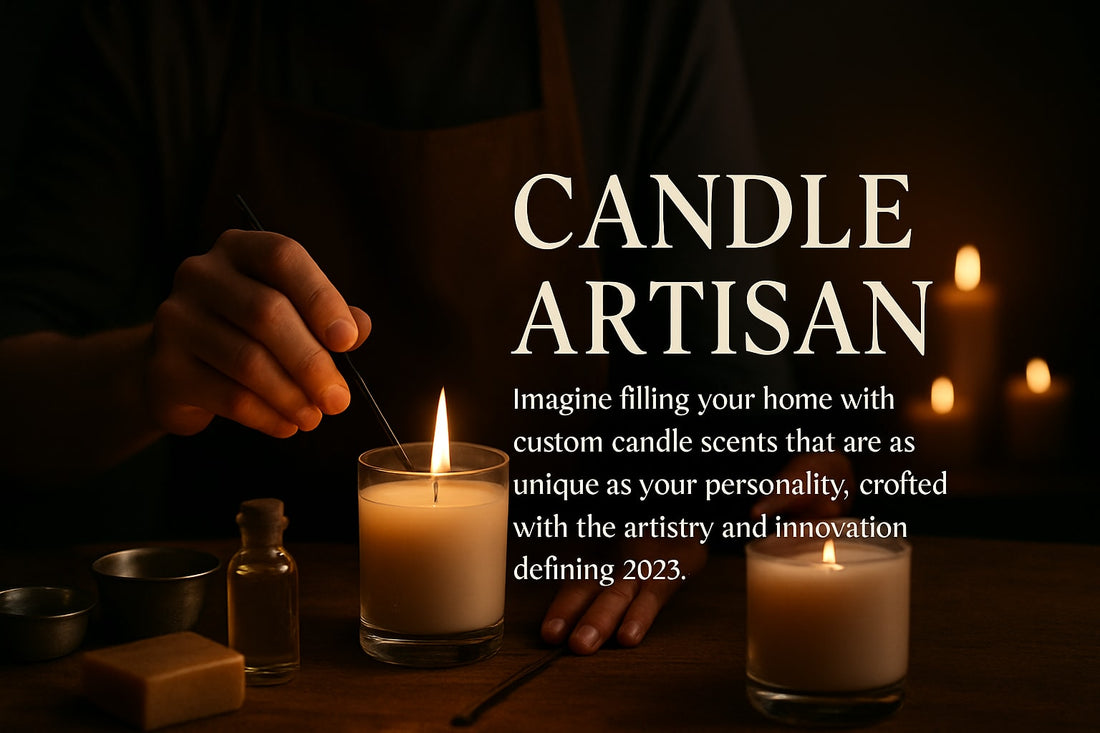
Candle Artisan Guide: Crafting Unique Scents in 2025
Share
Imagine stepping into a world where every candle artisan brings their creative vision to life, crafting scents that reflect personal stories and the spirit of 2025. This comprehensive guide is designed for both newcomers and seasoned candle artisan enthusiasts eager to elevate their craft.
You will uncover the foundations of candle making, explore the nuances of scent blending, and discover this year's most sought-after fragrances. Learn about sustainable materials and industry innovations that set your creations apart. Let this guide inspire you to innovate, experiment, and master the art of unique candle scents.
The Evolution of Candle Artistry: Trends & Innovations in 2025
The world of candle artisan craftsmanship has undergone a remarkable transformation. What once began as a simple means of illumination has blossomed into a sophisticated art form, where every detail is an opportunity for creativity and innovation. Today, the modern candle artisan is both artist and innovator, responding to shifting consumer desires and the spirit of the times.
Personalization and Storytelling Take Center Stage
Consumers are seeking more than just a pleasant aroma. They want candles that capture memories, tell personal stories, and reflect their unique identities. The rise of bespoke blends and narrative-driven scents has empowered every candle artisan to create products with real emotional resonance. Customization, from scent selection to vessel design, is now a defining feature in the artisan market.
Technology Sparks a New Era in Candle Making
In 2025, the candle artisan is leveraging cutting-edge technology to push boundaries. Scent diffusing gadgets, AI-assisted fragrance formulation, and 3D-printed molds are making it possible to craft candles with unprecedented precision and creativity. These advancements not only enhance scent complexity but also streamline production, allowing artisans to experiment and iterate more efficiently.
Market Growth and Industry Momentum
The global artisan candle market is thriving, with projected annual growth of 6.5 percent through 2025. This surge reflects both increased demand for unique, handcrafted products and a broader cultural appreciation for artistry. According to the Candle Market Size, Share & Industry Analysis, By Product Type, Raw Material, Scent Type, End-user, Distribution Channel, and Regional Forecast, 2025-2032, technological innovation and shifting consumer preferences are key forces shaping the industry’s future. For every candle artisan, understanding these dynamics is crucial for long-term success.
Sustainability and Eco-Conscious Design
Sustainability is no longer optional. Today’s candle artisan is embracing biodegradable waxes, upcycled vessels, and recyclable packaging. The use of materials like coconut wax and recycled glass not only appeals to eco-aware buyers but also demonstrates a commitment to responsible craft. Artisans are reimagining every aspect of production to reduce environmental impact and support a circular economy.
Global Inspiration and Fusion Scents
Candle artisans are drawing inspiration from around the world. Fusion scents, influenced by travel and multicultural experiences, are growing in popularity. From the earthy aroma of a rain-soaked forest to the crisp, modern notes of an urban loft, “moodscape” candles transport users to specific environments. These globally inspired blends reflect a new era where storytelling and sensory exploration go hand in hand.
Blending Tradition with Innovation
To stand out in 2025, every candle artisan must balance respect for traditional techniques with an openness to innovation. By merging artisanal craft with the latest technologies and trends, makers can create candles that are both timeless and ahead of the curve. The future belongs to those who are willing to experiment, adapt, and tell new stories through scent.
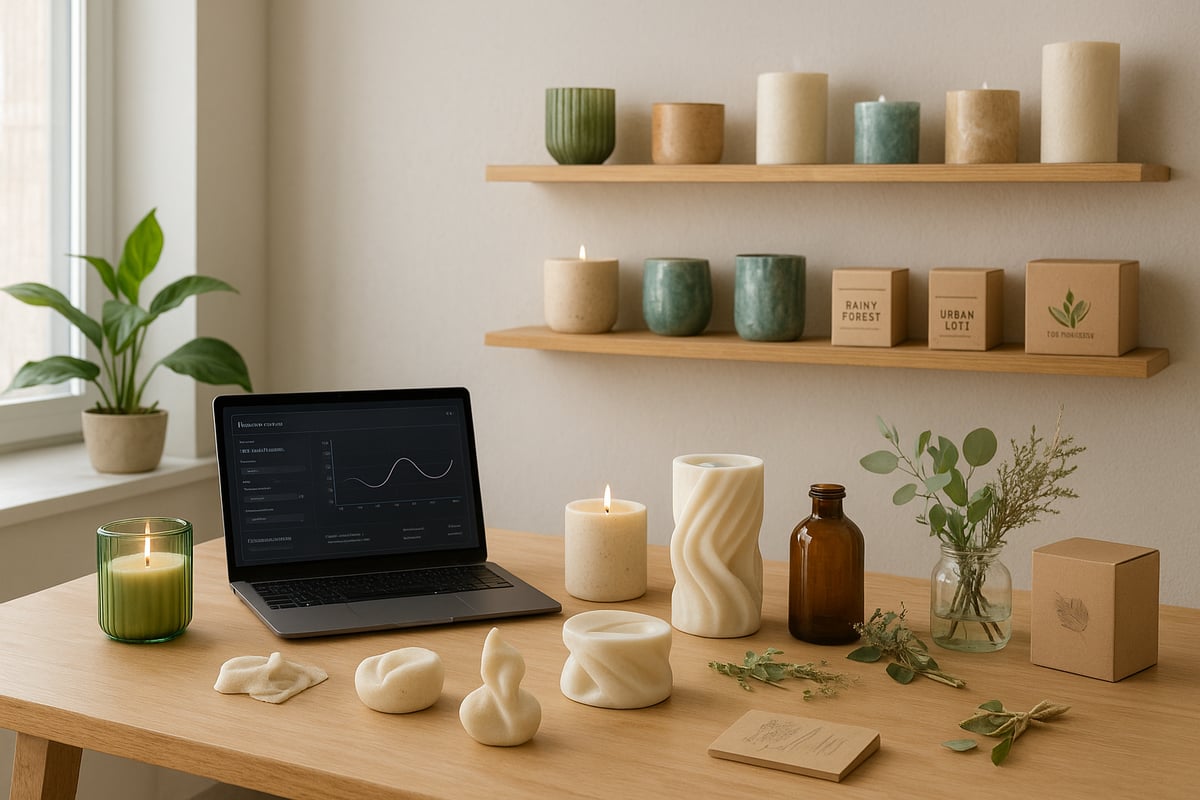
Essential Materials & Tools for Modern Candle Artisans
Modern candle artisan work demands both traditional craftsmanship and forward-thinking choices in materials and tools. Whether you are new to the craft or refining your expertise, selecting the right components is the first step to creating exceptional candles that stand out in 2025.
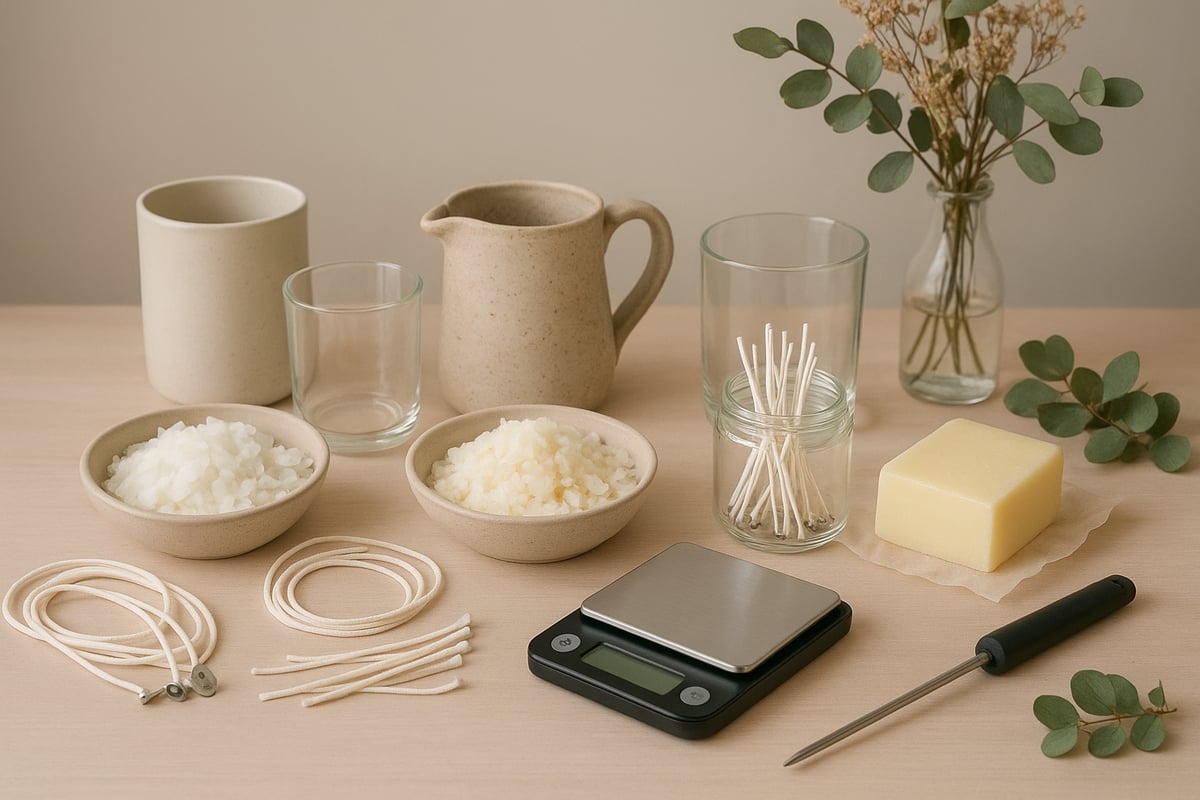
Wax Choices: Beyond Soy and Beeswax
Today’s candle artisan has a palette of innovative waxes to choose from, each offering unique benefits. While soy and beeswax remain popular, coconut and apricot waxes are gaining traction for their creamy texture and superior scent throw.
Comparison Table: Popular Wax Types
| Wax Type | Scent Throw | Burn Quality | Sustainability |
|---|---|---|---|
| Soy | Good | Clean | Renewable, biodegradable |
| Coconut | Excellent | Slow, even | Highly sustainable |
| Apricot | Good | Smooth | Often blended, eco-friendly |
| Beeswax | Mild | Long-lasting | Natural, but limited |
Soy and coconut blends, in particular, have emerged as top sellers in artisan markets for 2024 and 2025. A candle artisan who selects coconut wax will benefit from its eco-friendly profile and impressive fragrance diffusion.
Wicks, Vessels, and Additives
Choosing the right wick is vital for safety and performance. Cotton and wood wicks are popular with the modern candle artisan for their clean burn and aesthetic appeal.
Vessel trends are shifting toward ceramic, glass, upcycled items, and sculptural forms. For inspiration, explore unique candle holders and accessories that complement artisanal candles and elevate home décor.
Additives such as natural colorants, botanicals, and scent extenders allow the candle artisan to create distinctive visual and olfactory experiences. Recycled wine glasses and other upcycled vessels add character and sustainability to each creation.
Fragrance Oils, Essential Oils, and Natural Extracts
Sourcing premium fragrance and essential oils is essential for the candle artisan aiming for high-quality results. Fragrance oils offer a broad scent spectrum, while essential oils appeal to those prioritizing natural ingredients and wellness benefits.
- Fragrance oils: Consistent, long-lasting, and versatile.
- Essential oils: Natural, therapeutic, but sometimes less stable when heated.
- Natural extracts: Add depth and authenticity.
A candle artisan should always check for allergen labeling and comply with IFRA standards. Wellness-focused blends, such as lavender and eucalyptus, are increasingly popular among those who value both ambiance and holistic benefits.
Tools for Precision and Creativity
Modern candle artisan techniques rely on precision and innovation. Essential tools include digital thermometers for accurate temperature control, precision scales for consistent batching, and specialized blending tools for crafting unique scents.
- 3D-printed molds enable custom shapes.
- High-quality containers ensure safety and style.
- Innovative pouring techniques prevent tunneling and promote a smooth finish.
Safety is paramount. Every candle artisan should equip their workspace with gloves, goggles, and proper ventilation to ensure a safe, creative environment.
The Art and Science of Scent Blending
Blending fragrances is where the true artistry of a candle artisan shines. The ability to craft a scent that transforms an ordinary space into a personal sanctuary is both a science and an art. Whether you are just beginning or refining your craft, mastering scent blending is essential for creating candles that stand out in 2025.
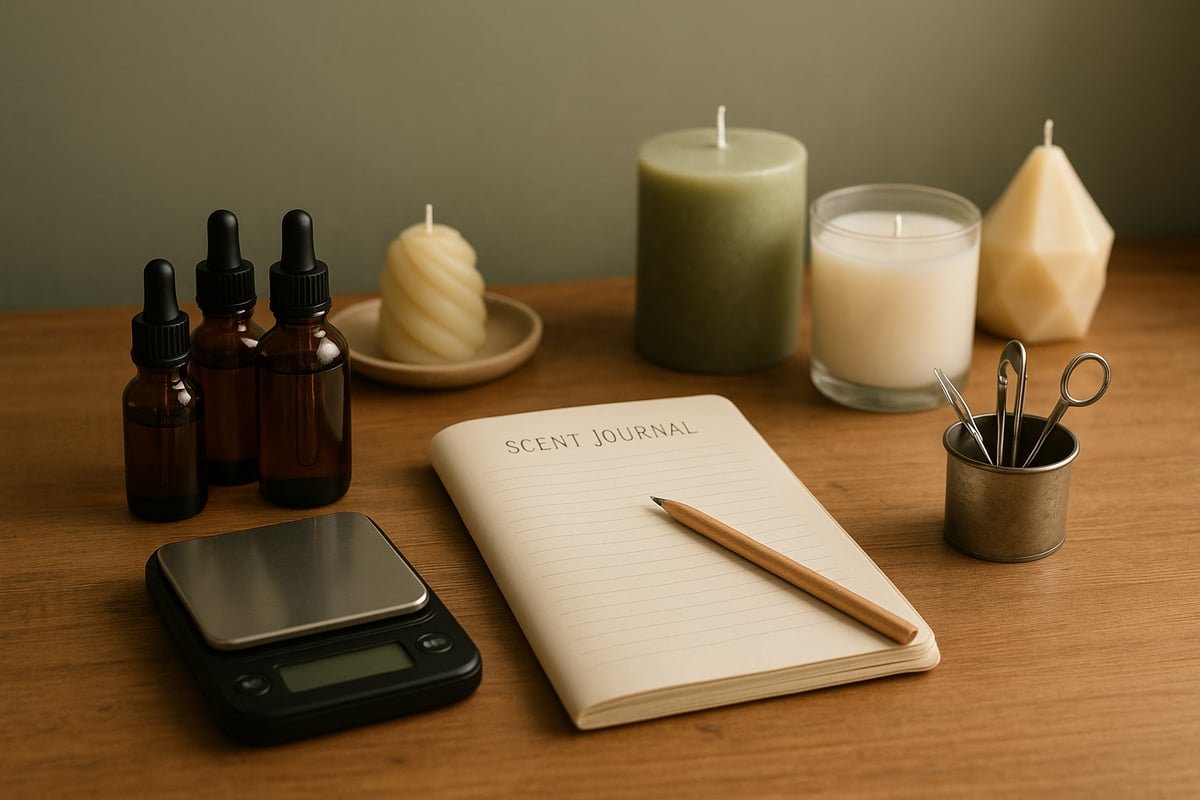
Understanding Fragrance Notes and Scent Structure
Every candle artisan must first understand the language of fragrance. Scents are built in layers: top, middle, and base notes. Top notes are the first impression, often citrus or herbal, and evaporate quickly. Middle notes, such as florals or spices, give body and character. Base notes like woods, musks, or resins anchor the blend, emerging as the candle burns.
Fragrance families give structure to scent creation. Common groups include floral, woody, gourmand, citrus, and herbal. A well-balanced blend evolves during burning, offering a dynamic experience. For example, a candle might start with zesty bergamot, reveal rose and cardamom at its heart, and finish with creamy sandalwood.
A candle artisan uses this knowledge to create candles that enhance home décor and mood. For more on how scent elevates interior spaces, see Candle use in home décor. Mastering scent structure is the foundation of every memorable candle.
Creating Signature Scents: Step-by-Step Process
For a candle artisan, developing a signature scent begins with inspiration. Perhaps you want to capture a coastal morning or the warmth of a fireside evening. Start by identifying your vision, then choose notes that tell that story. Select a top, middle, and base, considering how each will unfold during burning.
Keep a scent journal to document ratios and impressions. Begin with small test batches, adjusting quantities to achieve harmony. Curing the candle—allowing it to rest for a set period—lets the scent mature. Conduct burn tests to evaluate both cold and hot throw, ensuring your blend performs as intended.
Iterative testing is vital. A candle artisan may refine a “coastal morning” scent by tweaking the balance of sea salt, driftwood, and fresh linen. Over time, this process leads to a unique, consistent fragrance profile, setting your candles apart in the market.
Scent Layering and Multi-Dimensional Blends
Layering is the secret to creating depth and intrigue in a candle. A candle artisan can use fixatives and enhancers to extend the life of delicate notes. Start with a strong base, then build complexity by adding complementary middle and top notes.
For example, pairing smooth vanilla with smoky oud results in a sophisticated, multi-dimensional profile. Experiment with ratios and order of blending. The right combination offers a scent journey that evolves from the first light to the last flicker.
Proper layering ensures your candle artisan creations leave a lasting impression, transforming ordinary moments into sensory experiences.
Avoiding Common Pitfalls in Scent Blending
Even experienced candle artisan creators encounter challenges. Overpowering base notes can drown out lighter elements, while some oils may not blend well together or may fade during burning. Always test both cold (unlit) and hot (burning) throw to ensure the fragrance is strong and balanced.
Common issues include a blend that smells wonderful in the bottle but weak when burned. To troubleshoot, adjust ratios, try different waxes, or modify the blending temperature. A candle artisan who tests and documents each batch will overcome these hurdles and achieve consistent results.
Scent Inspiration: From Nature to Nostalgia
Scent inspiration is everywhere for a candle artisan. Draw from the changing seasons, travel adventures, cherished memories, or even art. Capture the coziness of a “Rainy Library” by blending paper, leather, and petrichor notes.
Do not be afraid to experiment or document your process. Every new blend adds to your creative toolkit and helps you develop a signature style. For a candle artisan, the journey of scent discovery is endless, limited only by imagination.
Step-by-Step Guide: Crafting Your Own Unique Candle Scents
Unlocking your creativity as a candle artisan begins with a clear, methodical process. Each step in crafting a signature scent not only reflects your personal vision, but also ensures your candles stand out in the marketplace. Whether you are a seasoned candle artisan or just embarking on your journey, this guide will walk you through each essential phase for successful, unique candle creation.
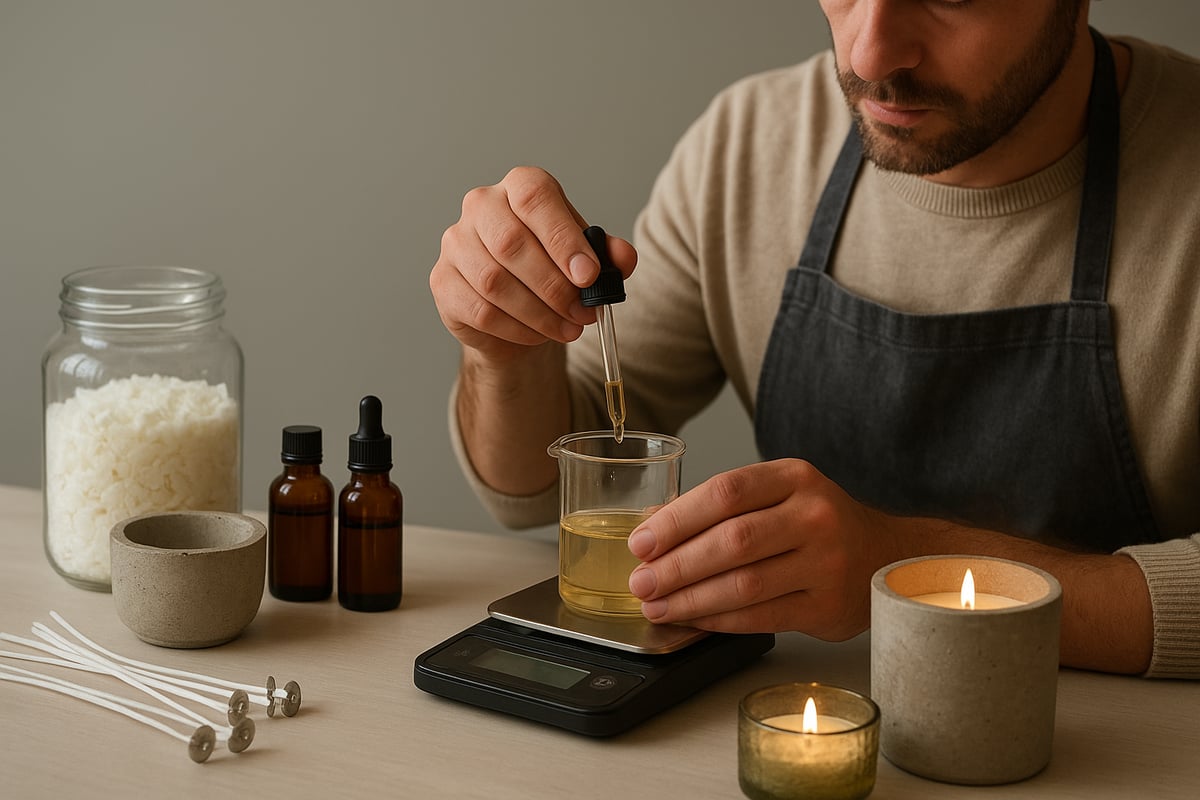
Step 1: Defining Your Scent Vision
Every successful candle artisan project starts with a clear vision. Ask yourself: What mood, story, or environment do you want your candle to evoke? Consider if your goal is to create a calming, spa-like aroma, an energizing citrus blend, or a scent that recalls a cherished memory.
Jot down your inspiration in a dedicated scent journal, a practice every candle artisan should adopt for consistency and growth. For example, imagine designing a candle for cozy winter evenings, blending spicy cinnamon and smoky vanilla, or crafting a fresh, invigorating scent for spring mornings.
By defining your scent’s purpose, you lay a strong foundation for every creative decision that follows. This clarity will help you select the right materials, notes, and design elements, ensuring your candle artisan work remains focused and intentional.
Step 2: Selecting Materials and Prepping Workspace
A well-prepared workspace is essential for any candle artisan. Begin by gathering the core materials:
- Wax (soy, coconut, apricot, or sustainable blends)
- Wicks (cotton, wood, specialty)
- Vessels (glass, ceramic, concrete, upcycled items)
- Fragrance and essential oils
- Tools (digital scale, thermometer, stirring rods)
- Safety gear (gloves, goggles, ventilation)
Organize your space so each item is easily accessible. Clean surfaces thoroughly to avoid contamination. Safety is paramount for the candle artisan, so ensure proper ventilation and keep a fire extinguisher nearby.
For vessel inspiration, consider exploring the Concrete artisan candle collection, which showcases modern, sustainable design options. Choosing the right vessel not only impacts the burn quality but also elevates the final product’s aesthetic appeal.
Step 3: Measuring and Melting Wax
Precision is key for a candle artisan during measurement and melting. Accurately weigh your wax and fragrance using a digital scale. This guarantees consistency across batches and ensures the scent ratio is just right.
Follow these steps:
- Measure wax based on vessel size.
- Use a double boiler or dedicated wax melter for safety.
- Monitor temperature closely with a digital thermometer.
Heat the wax slowly, aiming for the recommended melting point (usually between 70 and 85°C for most blends). Avoid overheating, as this can degrade fragrance oils and result in poor scent throw. A candle artisan must remain vigilant—scorched wax can impact both aroma and burn performance.
Step 4: Blending Fragrances and Pouring
Blending is where a candle artisan’s artistry truly shines. Add your chosen fragrance oils when the wax reaches the optimal temperature, typically around 65°C. This ensures maximum scent retention.
Gently but thoroughly stir for at least two minutes to achieve even distribution. Consider these tips:
- Use a slow, circular motion to avoid air bubbles.
- Test small batches to refine ratios.
- Record every adjustment in your scent journal.
When pouring, steady hands help avoid tunneling and create a smooth, attractive finish. Pour slowly into the center of the vessel, leaving room at the top. For advanced candle artisan results, experiment with layering fragrances or swirling in botanicals for visual interest.
Step 5: Curing, Testing, and Adjusting
Patience and observation set a candle artisan apart. Allow candles to cure for a minimum of 48 hours, though some blends benefit from up to two weeks for full scent development. During curing, the wax and fragrance fully bond, creating a more potent and balanced throw.
Conduct burn tests by lighting the candle in a controlled space. Evaluate both the cold throw (unlit scent) and hot throw (when burning). Use a table to log results:
| Test Aspect | Observation | Adjustment Needed |
|---|---|---|
| Cold Throw | Strong, Weak, Balanced | Increase/decrease scent |
| Hot Throw | Intense, Faint, Even | Adjust fragrance ratio |
| Burn Quality | Even, Tunneling, Sooting | Change wick size/type |
A candle artisan’s willingness to tweak and improve ensures each batch meets the highest standards. If the scent fades or smells off, revisit your ratios, wax type, or pouring temperature.
Step 6: Labeling, Packaging, and Storing
Finishing touches set the professional candle artisan apart. Label each candle with scent notes, burn instructions, and any allergen information. Comply with IFRA guidelines and local regulations to protect both your brand and your customers.
Packaging offers an opportunity to reinforce your brand identity. Choose eco-friendly materials and creative designs that reflect your candle artisan ethos. Store finished candles in a cool, dry place away from direct sunlight, preserving scent integrity until they reach your customers.
By following these steps, every candle artisan can craft unique, memorable scents that resonate in 2025’s competitive market.
Sustainability in Candle Making: Eco-Friendly Practices for 2025
Sustainability is now a defining value for every candle artisan aiming to thrive in 2025. Modern makers are rethinking their entire process, from sourcing wax to selecting vessels, to ensure that each candle leaves a positive impact on both the environment and the community. Here is how today’s candle artisan can embrace eco-friendly practices for a greener future.
Sourcing Sustainable Materials
For the modern candle artisan, choosing renewable and biodegradable materials is essential. Eco-friendly waxes like coconut, soy, and apricot offer excellent scent throw while minimizing environmental impact. Wicks made from organic cotton or wood support clean burning and sustainability.
Selecting ethical suppliers who prioritize transparency is equally crucial. Vessels crafted from upcycled glass or sustainable concrete are gaining popularity for their durability and style. Explore Sustainable concrete accessories for eco-friendly vessel options that complement artisan candle designs. By making conscious sourcing decisions, a candle artisan can reduce their carbon footprint and appeal to eco-minded consumers.
Reducing Waste and Energy Consumption
Efficient production is a hallmark of a responsible candle artisan. Planning batches carefully helps minimize leftover wax and fragrance oils. Many artisans now reuse molds and containers, transforming them into functional or decorative pieces.
Energy-efficient melting equipment and careful temperature control further lower resource use. Implementing recycling systems in the studio, such as collecting spent vessels for refilling, makes a meaningful difference. These small steps, when practiced consistently, reflect a candle artisan’s commitment to sustainable operations.
Safe, Non-Toxic Fragrance and Dye Choices
A candle artisan must prioritize the health of customers and the planet. Avoiding phthalates, parabens, and synthetic dyes is vital, as more buyers demand transparency and safety. Plant-based dyes and pure essential oils are leading choices for clean-burning, non-toxic candles.
According to recent data, 78 percent of buyers in 2024 preferred candles labeled non-toxic. By selecting high-quality, safe ingredients, the candle artisan builds trust and stands out in a competitive market. Always check for allergen labeling and adhere to IFRA standards to ensure compliance and consumer confidence.
Community and Environmental Impact
Supporting local suppliers and fellow artisans strengthens the sustainability movement. Many candle artisans participate in recycling or refill initiatives, encouraging customers to return vessels for reuse. These programs extend a candle’s life and nurture a sense of community.
Educational outreach, such as hosting workshops or sharing tips on eco-friendly candle care, further amplifies positive impact. When a candle artisan invests in community and environmental initiatives, they inspire others to adopt sustainable habits, making a collective difference for future generations.
Standing Out: Branding, Storytelling, and Selling Your Artisan Candles
The candle artisan landscape is more competitive than ever in 2025, with global demand for artisan candles continuing to rise. A strong brand presence is essential to stand out in a market projected to reach USD 20.10 billion by 2030, according to Global candle market projected to reach USD 20.10 billion by 2030. Let us explore how effective branding, compelling storytelling, and strategic selling can set your candle artisan business apart.
Crafting a Compelling Brand Story
Every successful candle artisan knows that a memorable brand story is the backbone of lasting customer relationships. Start by sharing your inspiration, whether it is a passion for scent, a love of craftsmanship, or a desire to create meaningful experiences.
Highlight what sets your journey apart. For example, some artisans feature stories about their creative process or the cultural influences behind their candle scents. Authentic storytelling builds trust and allows customers to connect emotionally with your products.
Consider weaving customer testimonials or behind-the-scenes snapshots into your narrative. This approach invites buyers to become part of your candle artisan journey and encourages loyalty.
Visual Identity: Design, Photography, and Packaging
A candle artisan’s visual identity is like a signature—distinct, consistent, and instantly recognizable. Invest in cohesive design elements, such as a logo, color palette, and typography that reflect your brand’s ethos.
Professional photography is key. Use high-quality images to showcase the textures, colors, and details of your candles. Consider lifestyle shots that place your products in real-world settings, enhancing their appeal.
Packaging should reinforce your brand values. Many candle artisans opt for eco-friendly materials, custom labels, and reusable containers. These choices not only look appealing but also communicate your commitment to sustainability and quality.
Leveraging Digital Platforms and Social Media
In 2025, a candle artisan’s online presence is vital for growth. Platforms like Instagram, TikTok, Etsy, and artisan marketplaces offer broad reach and direct engagement with customers. Share behind-the-scenes videos, scent creation tutorials, and customer stories to foster connection.
Use analytics tools to track engagement and refine your content strategy. Optimize product listings with clear descriptions and beautiful images. Data shows that 65% of artisan candle sales in 2024 originated from social platforms, emphasizing the power of digital marketing for candle artisan brands.
Consider collaborating with influencers or running targeted ads to expand your audience. Consistent, authentic online activity keeps your brand top-of-mind.
Customer Experience and Community Building
Exceptional customer experience distinguishes a candle artisan in a crowded market. Offer personalized services, such as custom scent consultations or engraved messages on candle vessels. Quick, attentive communication builds trust and encourages repeat business.
Develop community through loyalty programs, exclusive product launches, or hosting virtual candle-making workshops. These initiatives create a sense of belonging and reward customer engagement.
Encourage customers to share photos or reviews, and feature their stories on your social channels. This not only strengthens your candle artisan brand but also transforms buyers into advocates.
Navigating Markets, Pop-Ups, and Wholesale
Selling as a candle artisan extends beyond online platforms. Participate in artisan markets, pop-up events, and local boutiques to reach new audiences. Prepare an eye-catching display and offer samples to entice shoppers.
Explore wholesale opportunities with retailers who align with your brand values. Research pricing strategies and legal requirements to ensure profitability and compliance. For detailed analysis of growth trends and opportunities, consult the Candle Market Report by Wax Type, Category, Product, Distribution Channel, Countries and Company Analysis 2025-2033.
Scaling production may require new tools or partnerships, so plan ahead. By diversifying your sales channels, your candle artisan business can thrive in both local and global markets.
Future-Proofing Your Candle Artisan Skills
Staying ahead as a candle artisan in 2025 means embracing change, learning new techniques, and continually refining your craft. The landscape is evolving quickly, and those who prepare for the future will thrive in a competitive market.
Embracing Innovation and Continuous Learning
To remain a top candle artisan, it is essential to keep up with the latest trends in fragrance formulation and candle technology. Attend virtual masterclasses or webinars to expand your expertise. Invest in new tools, such as digital scent analyzers and precision pouring equipment, which can enhance both safety and creativity.
The integration of artificial intelligence and advanced scent formulation has already begun influencing the industry. For more on how these advancements will shape the future, see the Candle Market Report | Global Forecast From 2025 To 2033. By staying informed, you ensure your skills remain relevant and competitive.
Networking and Collaboration in the Artisan Community
Being part of a strong community is invaluable for a candle artisan. Join online forums, local associations, or social media groups dedicated to candle making. These networks provide support, inspiration, and opportunities for knowledge sharing.
Collaboration can spark creativity and open doors to new markets. Partner with local artists or businesses on limited edition scent releases. For example, co-creating a candle line with a ceramicist or painter can bring fresh perspectives and attract new customers.
Adapting to Consumer Preferences and Market Shifts
A successful candle artisan listens to customer feedback and watches for changes in consumer trends. The demand for wellness-oriented and functional scents continues to rise. Many customers now seek candles that support relaxation, focus, or mood enhancement.
Regularly review your product line and adapt as needed. Track bestsellers and experiment with new scent profiles. Consider developing candles with aromatherapy benefits or eco-friendly packaging to meet evolving expectations.
Setting Goals and Measuring Success
Strategic planning is critical for every candle artisan aiming for long-term growth. Set clear, achievable goals, both creative and financial. Monitor your sales data, customer reviews, and inventory to spot patterns and areas for improvement.
Use digital tools to manage orders, track expenses, and evaluate marketing campaigns. Celebrate creative milestones, such as launching a new scent or reaching a sales target. By measuring your progress, you can adjust your strategy and continue to build a sustainable artisan business.
